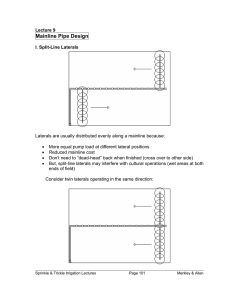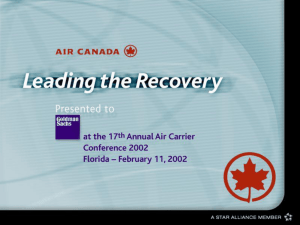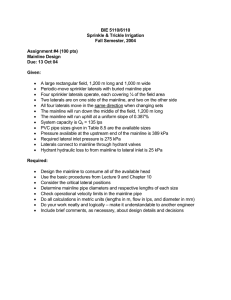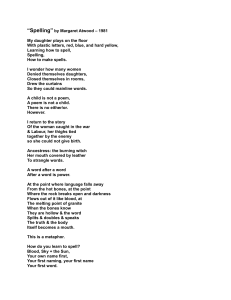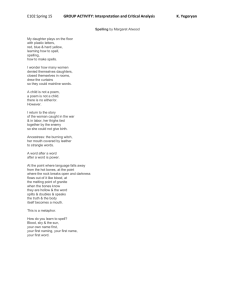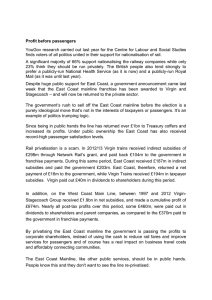BIE 5110/6110 Sprinkle & Trickle Irrigation Fall Semester, 2004 Assignment #5 (100 pts)
advertisement
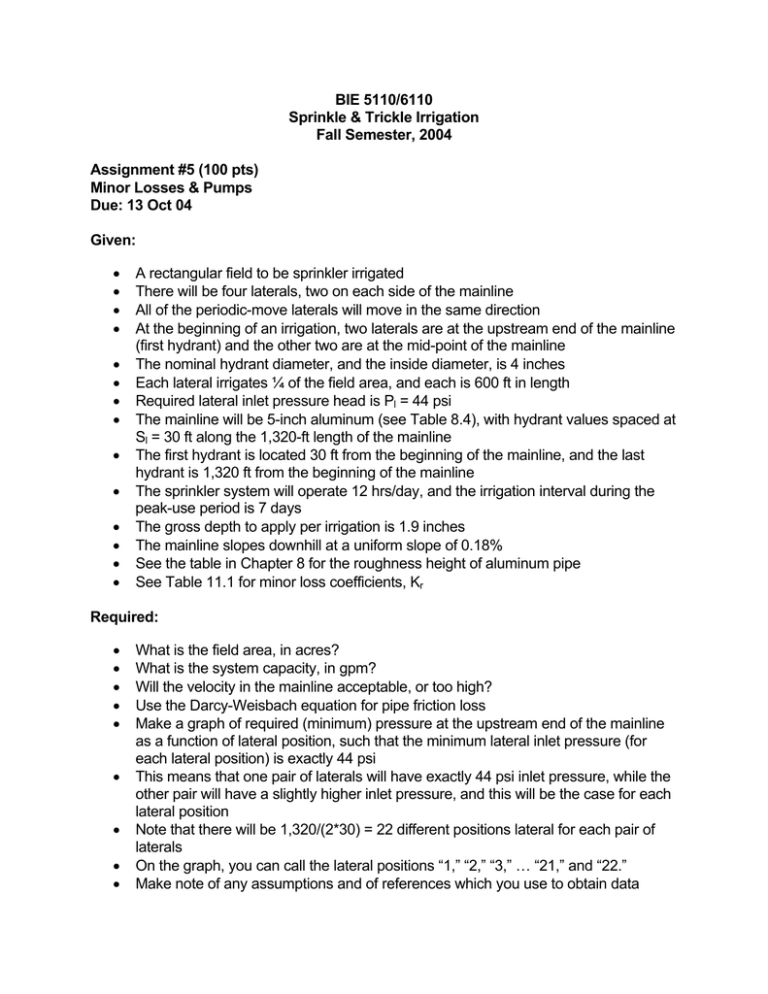
BIE 5110/6110 Sprinkle & Trickle Irrigation Fall Semester, 2004 Assignment #5 (100 pts) Minor Losses & Pumps Due: 13 Oct 04 Given: • • • • • • • • • • • • • • A rectangular field to be sprinkler irrigated There will be four laterals, two on each side of the mainline All of the periodic-move laterals will move in the same direction At the beginning of an irrigation, two laterals are at the upstream end of the mainline (first hydrant) and the other two are at the mid-point of the mainline The nominal hydrant diameter, and the inside diameter, is 4 inches Each lateral irrigates ¼ of the field area, and each is 600 ft in length Required lateral inlet pressure head is Pl = 44 psi The mainline will be 5-inch aluminum (see Table 8.4), with hydrant values spaced at Sl = 30 ft along the 1,320-ft length of the mainline The first hydrant is located 30 ft from the beginning of the mainline, and the last hydrant is 1,320 ft from the beginning of the mainline The sprinkler system will operate 12 hrs/day, and the irrigation interval during the peak-use period is 7 days The gross depth to apply per irrigation is 1.9 inches The mainline slopes downhill at a uniform slope of 0.18% See the table in Chapter 8 for the roughness height of aluminum pipe See Table 11.1 for minor loss coefficients, Kr Required: • • • • • • • • • What is the field area, in acres? What is the system capacity, in gpm? Will the velocity in the mainline acceptable, or too high? Use the Darcy-Weisbach equation for pipe friction loss Make a graph of required (minimum) pressure at the upstream end of the mainline as a function of lateral position, such that the minimum lateral inlet pressure (for each lateral position) is exactly 44 psi This means that one pair of laterals will have exactly 44 psi inlet pressure, while the other pair will have a slightly higher inlet pressure, and this will be the case for each lateral position Note that there will be 1,320/(2*30) = 22 different positions lateral for each pair of laterals On the graph, you can call the lateral positions “1,” “2,” “3,” … “21,” and “22.” Make note of any assumptions and of references which you use to obtain data Solution: 1. Field Area: The field is given to be rectangular. Note that there are 43,560 ft2/acre. The irrigated area is the length of the mainline (1,320 ft) multiplied by twice the length of one lateral (2 x 600 ft): (1,320)(1,200) = 36.4 acres 43,560 2. System Capacity: Use Eq. 5.4 and the given data: Qs = 453 Ad (36.4)(1.9) = 453 = 373 gpm fT (7)(12) 3. Velocity Checks: Table 8.4: 5-inch aluminum pipe has an inside diameter of 4.900 inches (0.408 ft). Note that the maximum recommended velocity, in general, for sprinkler systems is 5 to 7 fps. 3(a). Full system capacity in the mainline: VQs = Qs 4(373 gpm) = = 6.36 fps A π (60 s/min)(7.481 gal/ft 3 )(0.408 ft)2 3(b). Half system capacity in the mainline: VQs /2 = Qs 2(373 gpm) = = 3.18 fps 2 A π (60 s/min)(7.481 gal/ft 3 )(0.408 ft)2 3(c). Half system capacity through a hydrant valve: Vhydrant = Qs 2(373 gpm) = = 4.77 fps 2 A π (60 s/min)(7.481 gal/ft 3 )(0.333 ft)2 All of the above velocities are below 7 fps, so they are found to be acceptable. 4. Reynolds Numbers and Darcy-Weisbach f: The Reynolds number for a circular pipe is defined as: Re = VD 4Q = ν πD ν Assume a water temperature of 10°C. From the table on page 126 of the lecture notes (or from any other reference), the kinematic viscosity at this temperature is ν = 1.306(10)-6 m2/s. 4(a). Full system capacity in the mainline: ( R e )Q s 4(373 gpm)(0.3048 m/ft)2 = ≈ 184,000 π(448.86 gpm/cfs)(0.408 ft)(1.306E-6 m2 /s) 4(b). Half system capacity in the mainline: (Re )Q /2 = s 2(373 gpm)(0.3048 m/ft)2 ≈ 92,000 π(448.86 gpm/cfs)(0.408 ft)(1.306E-6 m2 /s) From the table on page 138 (Chapter 8) of the textbook, the roughness height of aluminum pipe (with couplers as an equivalent length of pipe) is 0.005 ft. Then, from the Swamee-Jain equation: fQs = 0.0213 and, fQs/2 = 0.0225 5. Velocity Heads: There are three different velocity heads to be considered, based on the three velocities given in 3(a) – 3(c) above. These are: 5(a). Full system capacity in the mainline: VQ2s 2g = (6.36 fps)2 = 0.628 ft 2(32.2 ft/s2 ) 5(b). Half system capacity in the mainline: VQ2s /2 (3.18 fps)2 = = 0.157 ft 2g 2(32.2 ft/s2 ) 5(c). Half system capacity through a hydrant valve: 2 Vhydrant 2g (4.77 fps)2 = = 0.353 ft 2(32.2 ft/s2 ) 6. Minor Loss Coefficients: From Table 11.2 for a 4-inch aluminum hydrant valve: Flow Path Past closed hydrant Past open hydrant Through open hydrant Kr 0.5 0.6 7.5 7. Calculating Hydraulic Losses: At the start of an irrigation, one pair of laterals is at the first hydrant (#1), which is 30 ft from the beginning of the mainline. The second pair of laterals is at a distance of 660 ft from the first pair, at hydrant #23. At each subsequent set, the laterals move Sl = 30 ft down the mainline. The second set will find the first pair of laterals at hydrant #2, and the second pair at hydrant #24. Finally, the last set of the irrigation will have the first pair at hydrant #22, and the second pair at hydrant #44 (the last one on the mainline). The minimum pressure head required in the mainline pipe at a open hydrant is the required lateral inlet pressure head of (44 psi)(2.31 ft/psi) = 102 ft, plus the head loss through the hydrant valve, which is: (hf )hydrant ⎛ 4.772 ⎞ V2 = Kr = 7.5 ⎜ ⎟ = 2.65 ft 2g 2(32.2) ⎝ ⎠ Then, the minimum pressure head required in the mainline pipe at a open hydrant is: hmain = 102 + 2.65 ≈ 105 ft which is constant for any lateral position. The following figure gives a schematic plan view of the field area: 1,320 ft 1,200 ft mainline downhill @ 0.18% Note that for every one of the 22 lateral positions, the second pair of laterals is always 660 ft downstream of the first pair of laterals. 7(a). Considering the First Pair of Laterals Make a table of lateral positions in which the number of upstream closed laterals increases by one for each new lateral position (because the pair of laterals moves further from the upstream end of the mainline). Thus, the pipe friction loss and the minor losses due to flow past a closed hydrant increase with each lateral position. On the other hand, the change in elevation partially offsets these friction losses. Note that from the upstream end of the mainline to the first pair of laterals, the discharge is equal to the entire system flow rate. Consider the following table: Lateral Position 1 2 3 4 5 6 7 8 9 10 11 12 13 14 15 16 17 18 19 20 21 22 First Pair of Laterals Distance to Pipe hf Number of (hf)minor Elev st 1 Pair (ft) Change (ft) (ft) US hydrants (ft) 30 -0.054 0.98 0 0.00 60 -0.108 1.97 1 0.31 90 -0.162 2.95 2 0.63 120 -0.216 3.93 3 0.94 150 -0.270 4.92 4 1.26 180 -0.324 5.90 5 1.57 210 -0.378 6.88 6 1.88 240 -0.432 7.87 7 2.20 270 -0.486 8.85 8 2.51 300 -0.540 9.84 9 2.83 330 -0.594 10.82 10 3.14 360 -0.648 11.80 11 3.45 390 -0.702 12.79 12 3.77 420 -0.756 13.77 13 4.08 450 -0.810 14.75 14 4.40 480 -0.864 15.74 15 4.71 510 -0.918 16.72 16 5.02 540 -0.972 17.70 17 5.34 570 -1.026 18.69 18 5.65 600 -1.080 19.67 19 5.97 630 -1.134 20.65 20 6.28 660 -1.188 21.64 21 6.59 Req'd at Mainline Inlet (ft) 105.9 107.2 108.4 109.7 110.9 112.1 113.4 114.6 115.9 117.1 118.4 119.6 120.9 122.1 123.3 124.6 125.8 127.1 128.3 129.6 130.8 132.0 7(b). Considering the Second Pair of Laterals Do the same thing as for the first pair of laterals, but considering that part of the mainline has the full system flow rate, and part has only half of the system flow rate. Also, the minor loss due to “line flow” past one open hydrant (location of the first pair of laterals) must be added to the head losses. The losses from the second pair of laterals to the upstream end of the mainline must be added to the 105-ft head requirement (see above) in the mainline at the location of the second pair of laterals. These losses include pipe friction and minor losses. Consider the following table (next page): 7(c). Extreme Position It is seen that for each of the 22 lateral positions, the second pair of laterals require a higher pressure head at the upstream end of the mainline. This is because the downhill slope of the mainline is very small, so the friction losses dominate the pressure variation along the mainline. Thus, the following graph is for the required pressure head at the upstream end of the mainline from the perspective of the second (downstream) pair of laterals for each position, thereby giving more than enough pressure in the mainline at the location of the first pair of laterals. Position 1 2 3 4 5 6 7 8 9 10 11 12 13 14 15 16 17 18 19 20 21 22 Second Pair of Laterals Distance to Distance to Elev Pipe Number of closed (hf)minor Req'd at Mainline US hydrants (ft) Inlet (ft) 1st Pair (ft) 2nd Pair (ft) Change (ft) hf (ft) 30 690 -1.242 6.70 21 2.10 112.6 60 720 -1.296 7.68 22 2.42 113.8 90 750 -1.350 8.67 23 2.73 115.0 120 780 -1.404 9.65 24 3.05 116.3 150 810 -1.458 10.63 25 3.36 117.5 180 840 -1.512 11.62 26 3.67 118.8 210 870 -1.566 12.60 27 3.99 120.0 240 900 -1.620 13.58 28 4.30 121.3 270 930 -1.674 14.57 29 4.62 122.5 300 960 -1.728 15.55 30 4.93 123.8 330 990 -1.782 16.53 31 5.24 125.0 360 1,020 -1.836 17.52 32 5.56 126.2 390 1,050 -1.890 18.50 33 5.87 127.5 420 1,080 -1.944 19.48 34 6.19 128.7 450 1,110 -1.998 20.47 35 6.50 130.0 480 1,140 -2.052 21.45 36 6.81 131.2 510 1,170 -2.106 22.43 37 7.13 132.5 540 1,200 -2.160 23.42 38 7.44 133.7 570 1,230 -2.214 24.40 39 7.76 134.9 600 1,260 -2.268 25.39 40 8.07 136.2 630 1,290 -2.322 26.37 41 8.38 137.4 660 1,320 -2.376 27.35 42 8.70 138.7 Required US Mainline Head (ft) 140 135 130 125 120 115 110 0 2 4 6 8 10 12 14 Sprinkler Lateral Position 16 18 20 22
